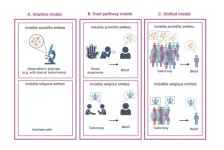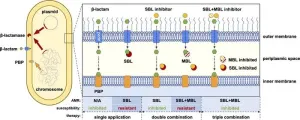(Press-News.org) An international research team led by the Hong Kong University of Science and Technology (HKUST) has uncovered in a recent research project that people’s beliefs in science and religion are primarily shaped by the words of others, rather than their personal experiences. The study could help enhance public understanding of people’s belief formation in important scientific issues, such as climate change and vaccination.
Conventionally, people are generally more confident about the existence of scientific phenomena, like oxygen, than religious phenomena, like God, as it is thought that people can experience oxygen, for instance, while it is harder to observe religious entities on one’s own.
The team, led by Prof. Mary Shaocong MA, a Research Assistant Professor from the Division of Social Science at HKUST, challenged the conventional view. They argued that both scientific and religious beliefs are primarily shaped by testimony or information we get from others, such as experts or our community, rather than personal experience.
The study highlights the decisive role of testimony in forming our beliefs and understanding of the world, contrary to the notion that direct experience is the main driver of scientific belief.
“Even when it seems like we’re experiencing something directly, our understanding is often heavily influenced by what we’ve been told by experts or our community. For example, witnessing a relative falling ill, it’s very hard for a child to detect that viruses cause illness; rather, they turn to others’ testimony, such as parents’ teaching, to understand the causal relations. Recognizing this can help determine the most effective way to communicate scientific information to the public. By highlighting the credibility and consensus of scientific evidence, it is possible to promote greater acceptance and confidence in scientific facts, especially regarding emerging scientific topics, such as climate change” says Prof. Ma.
“This insight is crucial for combating misinformation and enhancing public understanding and support for scientific matters, such as addressing climate change and getting vaccinated,” she further explains.
In the research, by reviewing empirical evidence in the past few decades, the team proposed a theoretical model that explains how people come to believe in the existence of invisible entities, such as germs in science or God in religion.
For example, it finds that people believe in germs because doctors and scientists tell us they exist, even though we cannot see them with our own eyes. Likewise, we infer that people get sick because of germs by learning this causal relation from others rather than discovering this connection through personal observation.
The model also establishes that the more credible the source of the information and the more people who agree with it, the more likely people are to believe it. “If many people around us agree that climate change is real, their consensus strengthens our belief in these concepts,” she says.
It shows that people's confidence in these phenomena is not because they have seen them directly but because they trust the sources that tell them about them.
Unlike previous models that proposed separate pathways for belief formation in science and religion, this model provides a unified explanation. It argues that others’ testimony, rather than direct experience, predominantly shapes beliefs in both domains.
The team's findings, realized in collaboration with researchers at Harvard University, Union College, and Massachusetts Institute of Technology, were recently published in a top international journal Trends in Cognitive Sciences by Cell Press.
END
Others’ words, not firsthand experience, shape scientific and religious belief formation, HKUST study finds
2024-06-04
ELSE PRESS RELEASES FROM THIS DATE:
Human activity contributed to woolly rhinoceros’ extinction
2024-06-04
Researchers have discovered sustained hunting by humans prevented the woolly rhinoceros from accessing favourable habitats as Earth warmed following the Last Ice Age.
An international team of researchers, led by scientists from the University of Adelaide and University of Copenhagen, used computer modelling to make the discovery, shedding light on an aeons-old mystery.
“Using computer models, fossils and ancient DNA, we traced 52,000 years of population history of the woolly rhinoceros across Eurasia at a resolution not previously considered possible,” said lead author Associate ...
Hot weather increases risk of emergency hospitalisations for patients with multimorbidity
2024-06-04
Australians are no strangers to long, hot summers, but new Griffith University research has looked at the impact of hot weather on patients with pre-existing chronic diseases and how it increases their risk of being hospitalised.
The research, recently published in eBioMedicine, found the risk of hospitalisation increased with the number of pre-existing chronic diseases during hot weather.
Individuals over the age of 65 with multimorbidity, defined as having two or more chronic diseases, were most at risk during hot weather.
Dr Zhiwei Xu from Griffith’s School ...
Sunshine spurs spending: Investors bet big on sunny days
2024-06-04
It’s often said we can’t control the weather. But what if the weather controls how and when we invest our money? More specifically, what if the skies control how much we’re willing to gamble in the stock market?
New research by the University of South Australia has found a connection between pleasant weather conditions and higher investment in lottery-like stocks.
Lottery-like stocks are cheap compared to other stocks and, like lottery tickets, they can be seen as an opportunity to make a substantial gain. However, the chance of a higher return is minimal, and it’s therefore considered a high-risk investment. A study by UniSA finance researchers ...
Novel triple antibiotic combination offers breakthrough in combatting antibiotic resistance
2024-06-04
In the ongoing battle against antibiotic resistance, a new study published in Engineering by Zhuoren Ling’s research team unveils a promising triple combination of antibiotics that significantly expands our arsenal against drug-resistant bacteria. Titled “The Triple Combination of Meropenem, Avibactam, and a Metallo-β-Lactamase Inhibitor Optimizes Antibacterial Coverage Against Different β-Lactamase Producers,” the research sheds light on a novel approach to tackle one of the most pressing global ...
Key nutrients help plants beat the heat
2024-06-04
LA JOLLA (June 4, 2024)—Global temperatures are on the rise, with experts projecting an increase of 2.7°F by 2050. Because plants cannot regulate their own temperatures, they are especially sensitive to these temperature changes. In higher temperatures, plants instruct their root systems to grow faster, creating long roots that stretch through the soil to absorb more water and nutrients. While this response may help the plants in the short term, new research suggests it’s both unsustainable for the plants and potentially ...
UTA scientists recognized nationally for inventions and innovation
2024-06-04
Researchers from The University of Texas at Arlington received 20 utility patents for their work in 2023, contributing to the University of Texas System’s overall ranking of No. 3 in the Top 100 U.S. Universities Granted U.S. Utility Patents in 2023 list.
Compiled by the National Academy of Inventors (NAI), the rankings are based on data obtained from the U.S. Patent and Trademark Office. The University of California system and Massachusetts Institute of Technology claimed the top ...
Inflight alcohol + cabin pressure may threaten sleeping passengers’ heart health
2024-06-04
The combination of alcohol plus cabin pressure at cruising altitude may threaten sleeping plane passengers’ heart health, particularly on long haul flights, suggests the first study of its kind, published online in the respiratory journal Thorax.
The duo lowers the amount of oxygen in the blood (SpO2) and raises the heart rate for a protracted period, even in the young and healthy, the findings indicate.
The higher the alcohol consumption, the greater these effects might be, particularly among older passengers and those with pre-existing medical conditions, say ...
High excess death rates in the West for 3 years running since start of pandemic
2024-06-04
Excess death rates have remained high in the West for three years running since the start of the COVID-19 pandemic, finds a data analysis of 47 countries published in the open access journal BMJ Public Health.
This is despite the implementation of various containment measures and the availability of COVID-19 vaccines, giving rise to “serious cause for concern,” say the researchers who call on governments and policymakers to thoroughly investigate the underlying causes.
The researchers wanted to gauge the effectiveness of the response to the health crisis ...
Facial thermal imaging + AI accurately predict presence of coronary artery disease
2024-06-04
A combination of facial thermal imaging and artificial intelligence (AI) can accurately predict the presence of coronary artery disease, finds research published in the open access journal BMJ Health & Care Informatics.
This non-invasive real-time approach is more effective than conventional methods and could be adopted for clinical practice to improve the accuracy of diagnosis and workflow, pending testing on larger and more ethnically diverse numbers of patients, suggest the researchers.
Current guidelines for the diagnosis of coronary heart disease rely on probability assessment of ...
New Durham University study shows selective breeding has constrained communication abilities in domestic dogs compared to wolves
2024-06-04
-With images and video-
A new study from researchers at Durham University has found that the process of domestication and selective breeding has limited the ability of domestic dogs to use facial expressions to convey affective states (emotions) as effectively as their wolf ancestors.
The research, published in Nature’s Scientific Reports, used an extended Dog Facial Action Coding System to analyse video recordings of captive wolves and domestic dogs during spontaneous social interactions and reactions to external stimuli.
The researchers identified nine distinct affective ...






